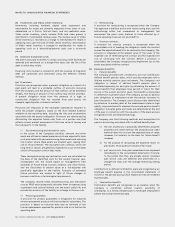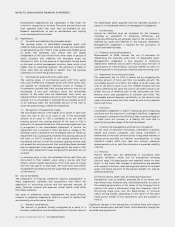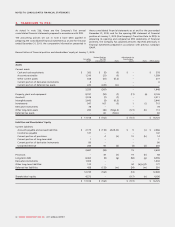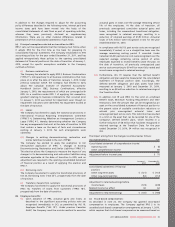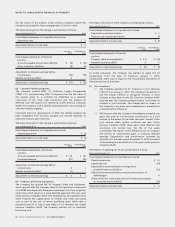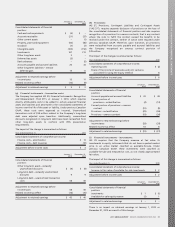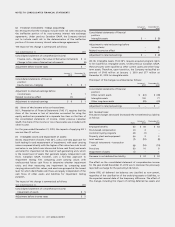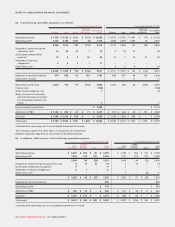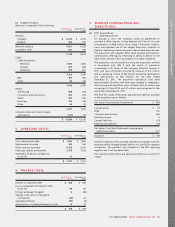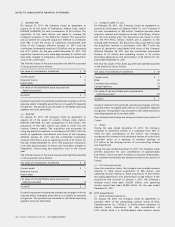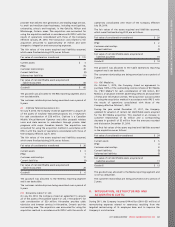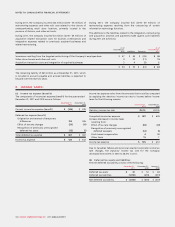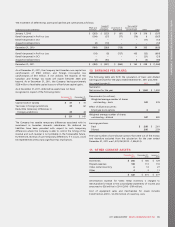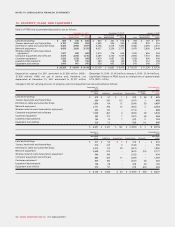Rogers 2011 Annual Report Download - page 100
Download and view the complete annual report
Please find page 100 of the 2011 Rogers annual report below. You can navigate through the pages in the report by either clicking on the pages listed below, or by using the keyword search tool below to find specific information within the annual report.
NOTES TO CONSOLIDATED FINANCIAL STATEMENTS
the fair values of the awards. Under previous Canadian GAAP, the
Company accounted for these arrangements at intrinsic value.
The impact arising from the change is summarized as follows:
Year ended December 31, 2010
Consolidated statement of comprehensive income:
Operating costs $ 3
Adjustment before income taxes $ 3
January 1,
2010 December 31,
2010
Consolidated statements of financial
position:
Accounts payable and accrued liabilities $ (9) $ (14)
Other long-term liabilities (6) (4)
Adjustment to retained earnings before
income taxes (15) (18)
Related income tax effect 4 –
Adjustment to retained earnings $ (11) $ (18)
(d) Customer loyalty programs:
The Company applied IFRIC 13, Customer Loyalty Programmes
(“IFRIC 13”), retrospectively. IFRIC 13 requires that the fair value of
the awards given to a customer be identified as a separate
component of the initial sales transaction and the revenue be
deferred until the awards are redeemed. Under previous Canadian
GAAP, the Company took a liability-based approach in accounting for
customer loyalty programs.
Consistent with the requirements of IFRS, the liability balance has
been reclassified from accounts payable and accrued liabilities to
unearned revenue upon transition.
The impact arising from the change is summarized as follows:
Year ended December 31, 2010
Consolidated statement of comprehensive income:
Operating revenue $ (3)
Adjustment before income taxes $ (3)
January 1,
2010 December 31,
2010
Consolidated statements of financial
position:
Accounts payable and accrued liabilities $ 55 $ 56
Unearned revenue (51) (55)
Adjustment to retained earnings before
income taxes 4 1
Related income tax effect (1) –
Adjustment to retained earnings $ 3 $ 1
(e) Property, plant and equipment:
The Company has applied IAS 16, Property, Plant and Equipment,
which requires that the Company identify the significant components
of its PP&E and depreciate these parts separately over their respective
useful lives which results in a more detailed approach than was used
under previous Canadian GAAP. The Company has also applied IAS 23
which requires the capitalization of interest and other borrowing
costs as part of the cost of certain qualifying assets which take a
substantial period of time to get ready for its intended use. Under
previous Canadian GAAP, the Company elected not to capitalize
borrowing costs.
The impact arising from these changes is summarized as follows:
Year ended December 31, 2010
Consolidated statement of comprehensive income:
Depreciation and amortization $ 2
Finance costs–capitalized interest (3)
Adjustment before income taxes $ (1)
January 1,
2010 December 31,
2010
Consolidated statements of financial
position:
Property, plant and equipment $ (11) $ (10)
Related income tax effect 3 3
Adjustment to retained earnings $ (8) $ (7)
As noted previously, the Company has elected to apply IAS 23
prospectively from the date of transition, January 1, 2010;
consequently, there was no impact to the consolidated statements of
financial position at that date.
(f) Joint ventures:
(i) The Company applied IAS 31, Interests in Joint Ventures
(“IAS 31”), at January 1, 2010. The Company has elected to
use the equity method to recognize interests in joint
ventures as described in note 2(c). Previous Canadian GAAP
required that the Company proportionately consolidate its
interests in joint ventures. This change had no impact on
the Company’s net assets and consequently is presented as
a reclassification difference.
(ii) IFRS requires that the Company immediately recognize any
gains that arise on non-monetary contributions to a joint
venture to the extent of the other venturers’ interest in the
joint venture when certain conditions are met. Under
previous Canadian GAAP, these gains were deferred and
amortized into income over the life of the assets
contributed. The impact of this difference was to recognize
$15 million of unamortized gains in opening retained
earnings. Depreciation and amortization increased by
$4 million for the year ended December 31, 2010 as a result
of eliminating the amortization of the gain under previous
Canadian GAAP.
The impacts of applying IAS 31 are summarized as follows:
Year ended December 31, 2010
Consolidated statement of comprehensive income:
Operating revenue $ 41
Operating costs (19)
Depreciation and amortization–change from
proportionate consolidation (12)
Depreciation and amortization–remove amortization of
deferred gain 4
Share of the loss of associates and joint ventures accounted
for using the equity method (10)
Adjustment before income taxes $ 4
96 ROGERS COMMUNICATIONS INC. 2011 ANNUAL REPORT




